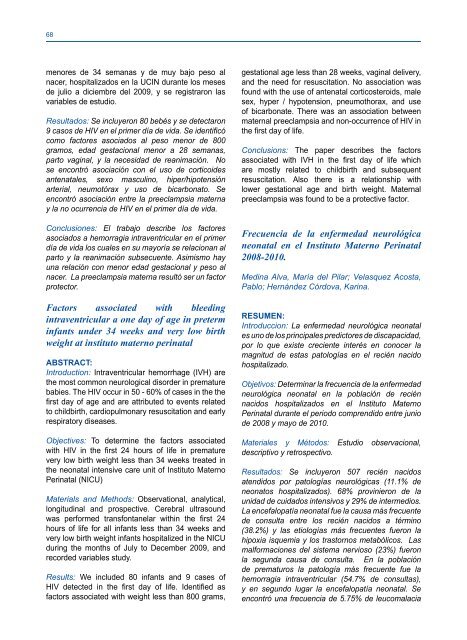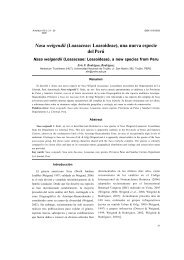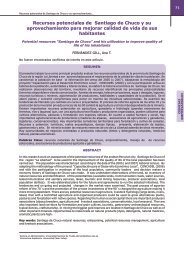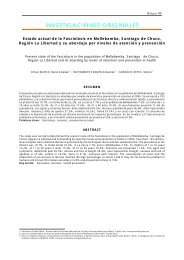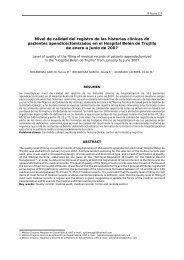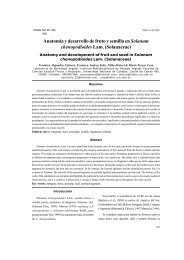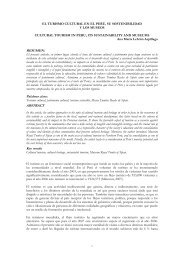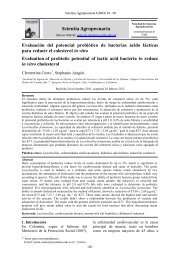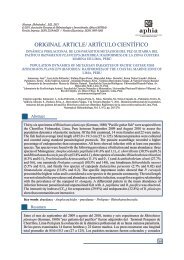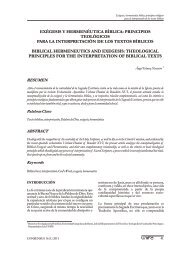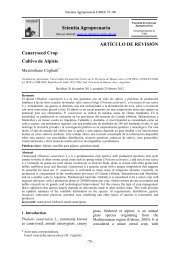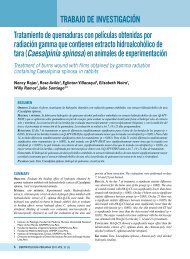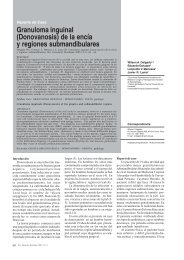temas libres presentados en el xxvi congreso ... - Revista Peruana
temas libres presentados en el xxvi congreso ... - Revista Peruana
temas libres presentados en el xxvi congreso ... - Revista Peruana
You also want an ePaper? Increase the reach of your titles
YUMPU automatically turns print PDFs into web optimized ePapers that Google loves.
68m<strong>en</strong>ores de 34 semanas y de muy bajo peso alnacer, hospitalizados <strong>en</strong> la UCIN durante los mesesde julio a diciembre d<strong>el</strong> 2009, y se registraron lasvariables de estudio.Resultados: Se incluyeron 80 bebés y se detectaron9 casos de HIV <strong>en</strong> <strong>el</strong> primer día de vida. Se id<strong>en</strong>tificócomo factores asociados al peso m<strong>en</strong>or de 800gramos, edad gestacional m<strong>en</strong>or a 28 semanas,parto vaginal, y la necesidad de reanimación. Nose <strong>en</strong>contró asociación con <strong>el</strong> uso de corticoidesant<strong>en</strong>atales, sexo masculino, hiper/hipot<strong>en</strong>siónarterial, neumotórax y uso de bicarbonato. Se<strong>en</strong>contró asociación <strong>en</strong>tre la preeclampsia maternay la no ocurr<strong>en</strong>cia de HIV <strong>en</strong> <strong>el</strong> primer día de vida.Conclusiones: El trabajo describe los factoresasociados a hemorragia intrav<strong>en</strong>tricular <strong>en</strong> <strong>el</strong> primerdía de vida los cuales <strong>en</strong> su mayoría se r<strong>el</strong>acionan alparto y la reanimación subsecu<strong>en</strong>te. Asimismo hayuna r<strong>el</strong>ación con m<strong>en</strong>or edad gestacional y peso alnacer. La preeclampsia materna resultó ser un factorprotector.Factors associated with bleedingintrav<strong>en</strong>tricular a one day of age in preterminfants under 34 weeks and very low birthweight at instituto materno perinatalABSTRACT:Introduction: Intrav<strong>en</strong>tricular hemorrhage (IVH) arethe most common neurological disorder in prematurebabies. The HIV occur in 50 - 60% of cases in the thefirst day of age and are attributed to ev<strong>en</strong>ts r<strong>el</strong>atedto childbirth, cardiopulmonary resuscitation and earlyrespiratory diseases.Objectives: To determine the factors associatedwith HIV in the first 24 hours of life in prematurevery low birth weight less than 34 weeks treated inthe neonatal int<strong>en</strong>sive care unit of Instituto MaternoPerinatal (NICU)Materials and Methods: Observational, analytical,longitudinal and prospective. Cerebral ultrasoundwas performed transfontan<strong>el</strong>ar within the first 24hours of life for all infants less than 34 weeks andvery low birth weight infants hospitalized in the NICUduring the months of July to December 2009, andrecorded variables study.Results: We included 80 infants and 9 cases ofHIV detected in the first day of life. Id<strong>en</strong>tified asfactors associated with weight less than 800 grams,gestational age less than 28 weeks, vaginal d<strong>el</strong>ivery,and the need for resuscitation. No association wasfound with the use of ant<strong>en</strong>atal corticosteroids, malesex, hyper / hypot<strong>en</strong>sion, pneumothorax, and useof bicarbonate. There was an association betwe<strong>en</strong>maternal preeclampsia and non-occurr<strong>en</strong>ce of HIV inthe first day of life.Conclusions: The paper describes the factorsassociated with IVH in the first day of life whichare mostly r<strong>el</strong>ated to childbirth and subsequ<strong>en</strong>tresuscitation. Also there is a r<strong>el</strong>ationship withlower gestational age and birth weight. Maternalpreeclampsia was found to be a protective factor.Frecu<strong>en</strong>cia de la <strong>en</strong>fermedad neurológicaneonatal <strong>en</strong> <strong>el</strong> Instituto Materno Perinatal2008-2010.Medina Alva, María d<strong>el</strong> Pilar; V<strong>el</strong>asquez Acosta,Pablo; Hernández Córdova, Karina.RESUMEN:Introduccion: La <strong>en</strong>fermedad neurológica neonatales uno de los principales predictores de discapacidad,por lo que existe creci<strong>en</strong>te interés <strong>en</strong> conocer lamagnitud de estas patologías <strong>en</strong> <strong>el</strong> recién nacidohospitalizado.Objetivos: Determinar la frecu<strong>en</strong>cia de la <strong>en</strong>fermedadneurológica neonatal <strong>en</strong> la población de reciénnacidos hospitalizados <strong>en</strong> <strong>el</strong> Instituto MaternoPerinatal durante <strong>el</strong> periodo compr<strong>en</strong>dido <strong>en</strong>tre juniode 2008 y mayo de 2010.Materiales y Métodos: Estudio observacional,descriptivo y retrospectivo.Resultados: Se incluyeron 507 recién nacidosat<strong>en</strong>didos por patologías neurológicas (11.1% d<strong>en</strong>eonatos hospitalizados). 68% provinieron de launidad de cuidados int<strong>en</strong>sivos y 29% de intermedios.La <strong>en</strong>cefalopatía neonatal fue la causa más frecu<strong>en</strong>tede consulta <strong>en</strong>tre los recién nacidos a término(38.2%) y las etiologías más frecu<strong>en</strong>tes fueron lahipoxia isquemia y los trastornos metabólicos. Lasmalformaciones d<strong>el</strong> sistema nervioso (23%) fueronla segunda causa de consulta. En la poblaciónde prematuros la patología más frecu<strong>en</strong>te fue lahemorragia intrav<strong>en</strong>tricular (54.7% de consultas),y <strong>en</strong> segundo lugar la <strong>en</strong>cefalopatía neonatal. Se<strong>en</strong>contró una frecu<strong>en</strong>cia de 5.75% de leucomalacia


